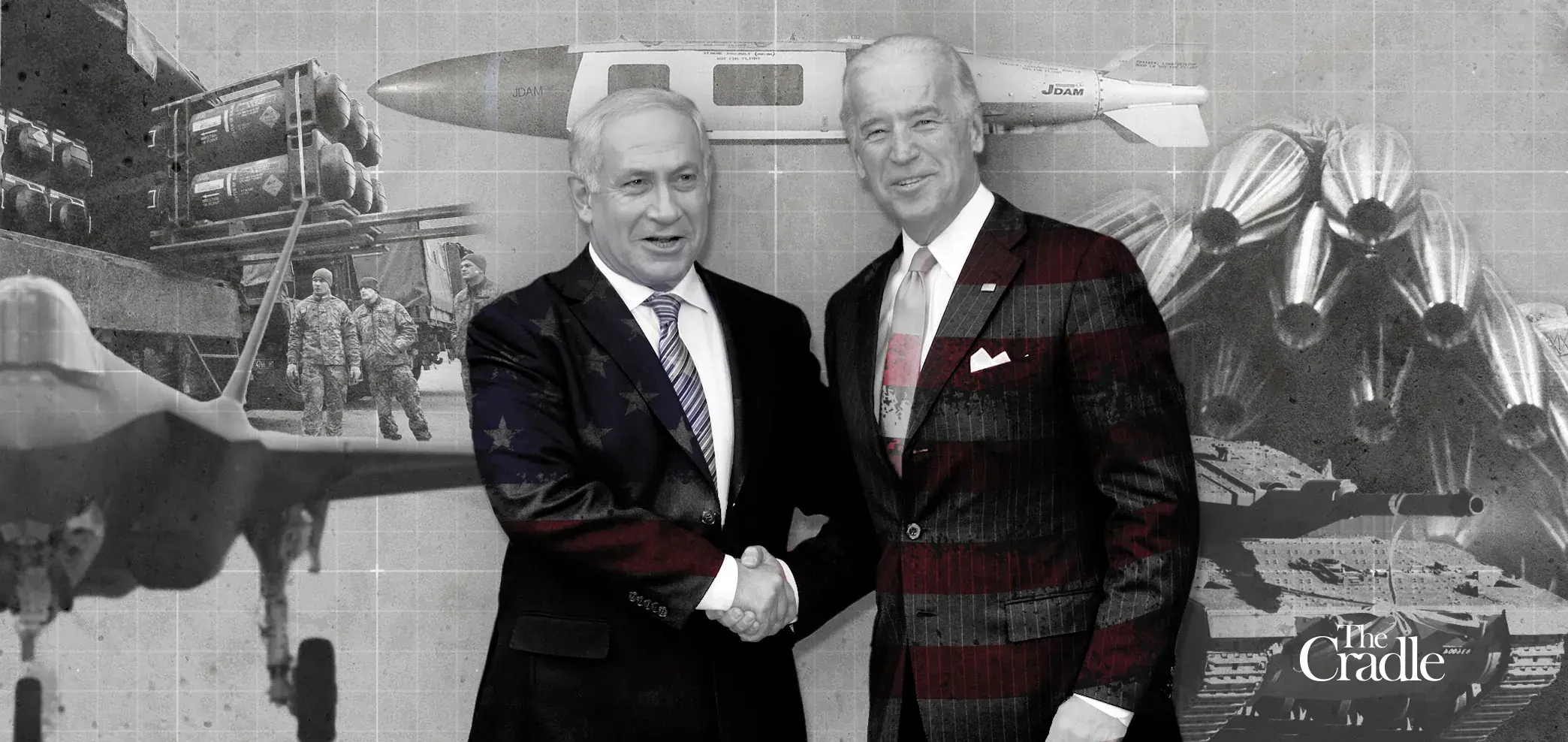"Israeli ground operations in the Gaza Strip have begun. The Financial Times says Israel will not reveal much about these military operations in order to avoid Hezbollah and Iran entering the war.
The Americans are now orchestrating Israel’s military campaign against the Gaza Strip. Washington believes this will maximize the potential of achieving both US and Israeli goals, without the conflict leading to a major regional conflagration - but it cannot guarantee that. The Israeli war on Gaza - managed, funded, and armed by the US - has a high possibility of turning into a regional war.
Impossible goals
Since 7 October, after Israel awoke to a nightmare called “Al-Aqsa Flood,” Tel Aviv has set itself goals so high that they are impossible to implement:
Israel’s first stated goal is the total elimination of Palestinian resistance movement Hamas, as announced by Prime Minister Benjamin Netanyahu, his Defense Minister Yoav Gallant, and other military and civilian officials in Tel Aviv.
They know that achieving this is next to impossible. Former Prime Minister Ehud Barak - also a former defense minister and army chief of staff - has said that eliminating Hamas is impossible because it (resistance) is an ideology that exists in people’s minds and hearts.
The only way this goal can be achieved practically is by getting rid of the entire population of the Gaza Strip. This matter was put on the table in Tel Aviv - and first came to our attention when Egyptian President Abdel Fattah Al-Sisi announced he was rejecting an Israeli proposal to allow Gaza residents to flood into the Sinai Peninsula.
The Kingdom of Jordan - adjacent to the occupied West Bank, which has no physical connection to Gaza - also rejected a similar Israeli proposal to allow Palestinians to flood into Jordan, via its Foreign Minister Ayman Al-Safadi.
These Israeli proposals to uproot and displace millions of Palestinians were not just an idea flitted about casually. Hebrew media outlet Mekovit has leaked an official Israeli Ministry of Intelligence document that proposed the displacement of more than 2.4 million Palestinians from Gaza to Egypt.
Just these two Israeli goals - in addition to being nigh impossible to achieve - could ignite all of West Asia and beyond. The region’s Axis of Resistance has sent several clear messages expressing its readiness to enter the war if Israel and its allies either threaten the existence and capabilities of the Palestinian resistance, and/or implement the project to displace Palestinians.
Resistance factions in Lebanon - including Hezbollah and allies such as Al-Fajr Forces, Hamas, and Palestinian Islamic Jihad (PIJ) - have been carrying out operations against Israeli army positions along the Lebanese-Palestinian border, on a daily basis, since 8 October.
US occupation military bases in Iraq and Syria have been subjected to more than 20 attacks by missiles and drones to date. From Syria, missiles are launched from time to time towards Israeli army positions in the occupied Golan Heights.
From Yemen, the Ansarallah resistance movement has launched three batches of missiles and drones, which have reportedly been intercepted by US and Israeli air defense systems.
On the Iraqi-Jordanian border, thousands of resistance supporters have gathered, hinting at the possibility of crossing the border to head toward occupied Palestinian territories in the West Bank. In general, the Axis has loudly proclaimed that it is not afraid to enter the war if the Palestinian resistance forces need that help.
Washington, leading Israel’s Gaza war
On the other side of this conflict, Washington has weighed in to offer full support to the occupation army in its military campaign against Palestinians. To date, the US has deployed two aircraft carriers and dozens of naval vessels in the Mediterranean Sea. Its air defenses (Patriot and THAAD systems) have been strengthened in the Arab states of the Persian Gulf, Jordan, and the occupied Palestinian territories. In addition, the Americans have deployed 2,000 special forces soldiers in Palestine, strengthened their forces and increased the number of combat aircraft in all their military bases in West Asia, and added military advisors to “assist” the Israeli army in its war on Gaza.
Both in practice, and publicly, the US government and military are running this Israeli war.
Washington has convinced Israel to dial down its objectives, firstly, by reversing plans for a large-scale ground invasion of the Gaza Strip, and replacing those with smaller, targeted operations with specific objectives.
These goals notably include: controlling uninhabited areas on the northern and central edges of the Gaza Strip; carrying out raids to kill the largest possible number of resistance fighters and destroy as much of the resistance’s infrastructure as possible; and launching operations to find or rescue Israeli captives held by the resistance.
Moreover, Washington is working hard to whitewash its right-wing Israeli ally’s genocidal assault on Gaza by introducing humanitarian aid in small quantities. At the same time, the US seeks to get rid, even if only partially, of the burden of Israeli captives, via Qatari-mediated negotiations to release a number of Israeli and foreign prisoners held by the Palestinian resistance since 7 October.
Although Tel Aviv prefers to wrap up the prisoner file in one go, the resistance refuses to do so: it seeks to maintain this power card, whether for the purpose of negotiating the release of more than 7,000 Palestinian captives held in Israeli detention centers, to negotiate Gaza’s reconstruction after the war - or to lift Israel’s siege over the beleaguered territory.
What can the ground war achieve?
On the night of 27-28 October, the Israeli army began to occupy agricultural lands in northern Gaza, and penetrated - from its eastern borders - into a sparsely built-up area in the center of the Strip.
Tel Aviv’s goal was to cut off the northern part of Gaza - which includes the heavily populated Gaza City - from the south, and to continue to apply fierce pressure on the city and its surroundings in a protracted battle to wear down its inhabitants. This operation was flanked with air and ground bombardment, the likes of which Palestine has never, ever witnessed before.
In the past two days, Palestinian resistance forces have managed to confront the enemy with anti-armor missiles, carried out an operation behind enemy lines near the Erez crossing, continued to fire missiles toward Israeli cities and military sites, and confronted an infiltration by Israeli armored vehicles into Wadi Gaza, an area in the middle of the Strip.
In the meantime, the US is working overtime to ensure that Israel’s enemies do not interfere in the war by threatening them with diplomatic messages, fleets, planes, and soldiers - which has de facto transformed this armed conflict from a broad and rapid operation into a low-boil, long-term war.
Washington has thrown everything but the kitchen sink at Israel: military cover, weapons, operations management, and even engineering the theater of operations to bolster the restoration of Israel’s image of deterrence. The US is betting that the military pressure on Hamas, in addition to the humanitarian burden it has placed on it, will eventually lead to political concessions by the Palestinian resistance. So far, Israel has killed nearly 10,000 civilians in Gaza, and has either damaged or partially or completely destroyed most civilian buildings In the Gaza Strip.
‘Israel lost the war’
Despite the oversized US assistance, Israel’s military position is more fragile than it has been in decades. As former Deputy Chief of Staff of the Israeli Defense Forces General Yair Golan strikingly tweeted on October 27: “We lost the war. No step, no matter how strong or successful, is able to erase the defeat of October 7. However, from this failure, there must be a political victory that will ultimately lead to the disarmament of the Gaza Strip."
This is Washington’s ultimate political goal too. But to reach this end, the US must juggle an infinite number of variables, any of which could set the region afire. Without even offering a light at the end of the tunnel - i.e., a political solution to the Palestinian plight - the US, and its unconditional, early war support for Israel, has attracted an improbable number of regional armies and militias to the conflict in Gaza: the Israeli army, US fleets, marines, and special forces in the eastern Mediterranean and West Asia, 50,000 resistance fighters in Gaza, tens of thousands of resistance fighters in Lebanon, tens of thousands of resistance fighters in Iraq, hundreds of thousands of fighters in Yemen, naval vessels from Britain and other western nations deployed to ensure Israel security.
This, without even considering the game-changing arrival of Iran’s armed forces and missile batteries into the war.
Amidst this huge number of troops exchanging fire, any one error could lead to the outbreak of a regional war that would, in reality, be a global war, since the US is the conflict’s main actor. This is akin to bringing a herd of elephants into a china shop, and remaining convinced all the while that there is a force capable of keeping them calm.
The bottom line? The US is presenting itself as a guarantor that Israel’s assault on Gaza will remain territorially limited, but is, in reality, adding every possible ingredient to this conflict that could transform it into a regional war."


i thought it was a proxy war against Iranian intrests
deleted by creator